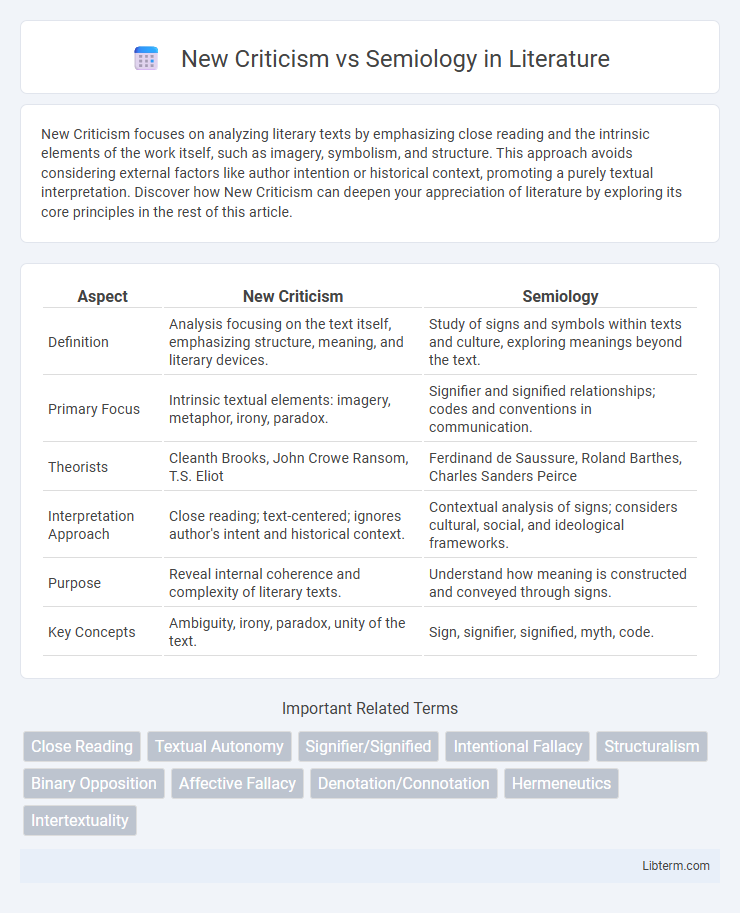New Criticism focuses on analyzing literary texts by emphasizing close reading and the intrinsic elements of the work itself, such as imagery, symbolism, and structure. This approach avoids considering external factors like author intention or historical context, promoting a purely textual interpretation. Discover how New Criticism can deepen your appreciation of literature by exploring its core principles in the rest of this article.
Table of Comparison
| Aspect | New Criticism | Semiology |
|---|---|---|
| Definition | Analysis focusing on the text itself, emphasizing structure, meaning, and literary devices. | Study of signs and symbols within texts and culture, exploring meanings beyond the text. |
| Primary Focus | Intrinsic textual elements: imagery, metaphor, irony, paradox. | Signifier and signified relationships; codes and conventions in communication. |
| Theorists | Cleanth Brooks, John Crowe Ransom, T.S. Eliot | Ferdinand de Saussure, Roland Barthes, Charles Sanders Peirce |
| Interpretation Approach | Close reading; text-centered; ignores author's intent and historical context. | Contextual analysis of signs; considers cultural, social, and ideological frameworks. |
| Purpose | Reveal internal coherence and complexity of literary texts. | Understand how meaning is constructed and conveyed through signs. |
| Key Concepts | Ambiguity, irony, paradox, unity of the text. | Sign, signifier, signified, myth, code. |
Introduction to New Criticism and Semiology
New Criticism emphasizes close reading and analysis of the text itself, focusing on elements such as imagery, symbolism, and structure without considering external contexts like authorial intent or historical background. Semiology, or semiotics, studies signs and symbols within texts as part of a broader system of meaning, analyzing how language and cultural codes influence interpretation. Both approaches prioritize textual elements but differ in scope: New Criticism isolates the text, while Semiology situates it within larger communicative processes.
Historical Background and Origins
New Criticism emerged in the early 20th century as a formalist approach emphasizing close reading and intrinsic analysis of texts, rooted primarily in Anglo-American literary scholarship. Semiology, developed by Ferdinand de Saussure in the early 20th century and later expanded by Roland Barthes, originated from structural linguistics and focuses on signs and symbols as fundamental units of meaning in cultural communication. The contrast between New Criticism's focus on textual autonomy and Semiology's exploration of language systems reflects their distinctive intellectual trajectories and foundational theories.
Key Theoretical Foundations
New Criticism centers on close reading and text-intrinsic analysis, emphasizing the autonomy of the literary work and the unity of form and content. Semiology, developed by Ferdinand de Saussure, investigates signs and symbols within language, focusing on the relationship between the signifier and the signified to uncover meaning through cultural and social codes. While New Criticism prioritizes the text itself, Semiology contextualizes meaning within systems of signs, highlighting broader semiotic structures influencing interpretation.
Major Proponents and Influencers
New Criticism, championed by John Crowe Ransom, Cleanth Brooks, and T.S. Eliot, emphasizes close reading and the intrinsic value of the text, rejecting authorial intent and historical context. Semiology, founded by Ferdinand de Saussure and expanded by Roland Barthes, studies signs and symbols as fundamental components of meaning-making in language and literature. Both approaches revolutionized literary theory by shifting focus--New Criticism to textual analysis and Semiology to the structures of cultural communication.
Approach to Textual Analysis
New Criticism emphasizes close reading of the text itself, focusing on intrinsic elements such as imagery, symbolism, and structure to uncover meaning without considering external contexts. Semiology, or semiotics, analyzes texts through signs and symbols within a broader system of cultural and social codes, interpreting meaning as constructed by language and societal conventions. This contrast highlights New Criticism's micro-level textual focus versus Semiology's macro-level examination of sign systems influencing interpretation.
Role of the Reader and Author
New Criticism emphasizes the text itself as an autonomous entity, minimizing the roles of both the reader and the author by focusing strictly on close reading and textual analysis. Semiology, derived from Saussurean linguistics, foregrounds the dynamic interaction between the signifier and signified, highlighting the active role of the reader in interpreting signs and constructing meaning. In this framework, the author's intent is less central as meaning emerges through the reader's engagement with the cultural and linguistic codes embedded in the text.
Concepts of Meaning and Interpretation
New Criticism emphasizes close reading and the text's intrinsic features as sources of meaning, treating the literary work as a self-contained unit without recourse to external context. Semiology, rooted in structuralism, analyzes meaning through signs and symbols within cultural and linguistic systems, highlighting the relationship between signifiers and the signified. Interpretation in New Criticism seeks objective understanding by uncovering textual unity, whereas Semiology embraces multiple meanings shaped by cultural codes and sign processes.
Criticisms and Limitations
New Criticism is criticized for its strict focus on the text itself, neglecting historical, social, and authorial contexts, which limits a comprehensive understanding of literature. Semiology faces limitations due to its complex theoretical framework, often prioritizing abstract sign systems over the emotional and aesthetic experience of texts. Both approaches can overlook the cultural and ideological influences that shape meaning and reader interpretation.
Impact on Literary Studies
New Criticism revolutionized literary studies by emphasizing close reading and text-centric analysis, isolating the text from historical or authorial context to uncover intrinsic meaning. Semiology introduced the study of signs and symbols, expanding literary analysis to include cultural codes, language structures, and the underlying systems shaping textual meaning. The impact on literary studies is profound, shifting focus from isolated textual interpretation to integrating linguistic and cultural frameworks for a multidimensional understanding of literature.
Contemporary Relevance and Applications
New Criticism, emphasizing close reading and textual autonomy, retains relevance in fostering analytical precision and interpretive rigor in literary studies. Semiology, rooted in structural linguistics, applies broadly across media, enhancing the understanding of cultural codes and communication in contemporary digital and visual contexts. Both frameworks contribute essential tools for dissecting meaning and discourse in modern interdisciplinary research and digital humanities.
New Criticism Infographic

 libterm.com
libterm.com